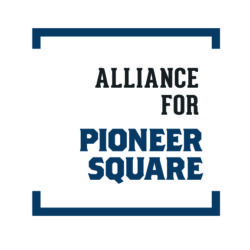
Meet Liz:
Pioneer Square has an unprecedented number of projects impacting the public realm: reclaiming alleys, redesigning streets and parks, fixing curbs and medians, waterfront, parking, and bike lanes. All this and more are all-in-a-day’s work for Liz Stenning, our Deputy Director. A friendly and familiar face in the neighborhood, Liz is all about ongoing improvements to our public realm from curb cuts to crosswalks.
Occidental Mall:
Occidental Mall was created in 1972, when the City of Seattle commissioned Jones & Jones Architects Landscape Architects to restore Pioneer Park and the historic pergola and create Occidental Park. Occidental Mall, also designed by Ilze Jones, constitutes one a cohesive array of open spaces in Pioneer Square. Occidental Mall is a one block pedestrian mall southern extension of the large 0.6 acre Occidental Park. Pioneer Park, Occidental Park, Occidental Mall- along with the Pioneer Passage and Nord Alley lanes signify the heart of Pioneer Square’s signature brick streets (which stretch from Yesler to King)
Occidental Mall’s transformation can be seen through this online resource’s comparison of the space between the early 1900’s and the early 2007’s .
Liz this week:
Liz is excited to speak about one ongoing public realm improvement in Pioneer Square. The Alliance for Pioneer Square was funded for brick renovation work through the City of Seattle Office of Economic Development Only in Seattle grant. Over the past few months, SDOT masons have been strategically repairing the brick-lined pathways in Pioneer Square. The first step to brick repair involved Alliance staff documenting each area throughout the Occidental area where damaged bricks were present. Next, the damaged areas were prioritized based on the extent of the damage, threat to pedestrian usage and available funding.

Brick repair is necessary to ensure that streets, sidewalks and walkways are usable by pedestrians, cyclists, and drivers alike. “It is important to keep Pioneer Square’s infrastructure healthy,” Liz notes. Brick are susceptible to damage from all kinds of use – feet, bikes, trucks, and cars. “I’ve seen cracked bricks due to tree root growth and also due to something heavy being dropped on them,” Liz recalls, “but most bricks are intact”. Some bricks throughout the neighborhood have not been rehabilitated since their original installation in the 1970’s. “The bricks are a fabric of the neighborhood,” Liz observes, “and with that comes required maintenance.”
We caught up with two of the City of Seattle Department of Transportation masons as they worked along the sidewalk on Main Street next to Occidental Square Park along Main St. The masons were delicately replacing damaged bricks with strategic precision to preserve as many historic bricks as possible. The masons are so skilled that an average pedestrian trekking through the neighborhood may not notice the newly installed brick- even we had a hard time differentiating the old from the new! Next time you’re out walking, check out the lovely bricks walkway!

